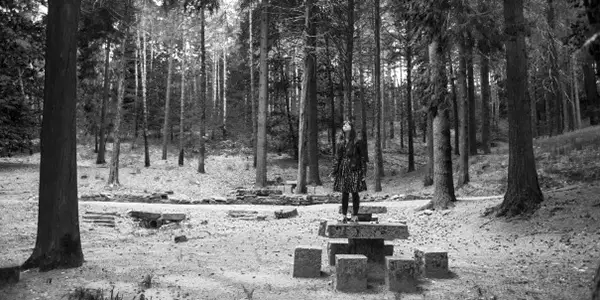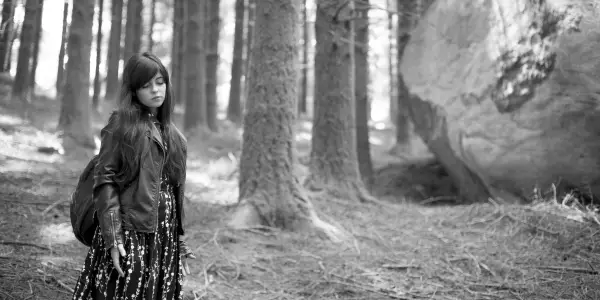THE FOREST OF THE LOST SOULS: A Unique Genre Fusion

Darryl A. Armstrong works in marketing and advertising and writes…
To talk about Portuguese director José Pedro Lopes’ debut feature film, The Forest of the Lost Souls, we must begin on the other side of the world in northwestern Japan by Mount Fuji. There, the Aokigahara forest, known as The Sea of Trees or The Suicide Forest, has become an infamous location for committing suicide. In the 1970’s an average of 20 documented suicides occurred per year in the forest. That number has risen to 108 in 2004 and in 2010 over 200 made the pilgrimage to the forest for the purpose of killing themselves, with 54 successfully completing the act.

The area has a long history as a spiritual and sacred place, and it’s important to note that Japanese culture does not view suicide as taboo or immoral. In fact, for most of its history, the act has been viewed as a way to regain honor in the face of personal or public failure. Still, today there are signs placed at the head of some trails encouraging hikers to consider their families and contact suicide prevention organizations.
Aokigahara is thought to have been a place of historical senicide–a place where struggling peasants abandoned their elderly (and sometimes young) who they could no longer afford to feed or care for to die. In 1960, Japanese crime novelist, Seichō Matsumoto, an Ellery Queen enthusiast, wrote Nami no Tou, or Tower of Waves, which featured a woman travelling to the forest for the purpose of killing herself. More recently, the forest’s macabre history has become the subject of a host of Japanese pop culture, including the manga series Kurosagi Corpse Delivery Service and an episode of Satoshi Kon‘s anime Paranoia Agent.
It has also begun reaching into international awareness, as the focus of a comic series, The Suicide Forest by El Torres, the Natalie Dormer starring The Forest, Gus Van Sant’s film The Sea of Trees which featured Matthew McConaughey, Naomi Watts, and Ken Watanabe, and a recent episode of the Netflix series Dark Tourist.
An Old Man and a Goth Girl Enter a Forest
The Forest of the Lost Souls abandons the Japanese location and transplants the idea of a suicide forest to director Lopes’ native Portugal. Unlike The Forest, which pushed aside any existential questions around the idea to focus on psychological and supernatural scares, or The Sea of Trees, which mixed family focused drama with elements of spirituality, The Forest of the Lost Souls takes an entirely different approach. Actually, it takes a couple different approaches.

The film starts with a young woman, Irene (Lília Lopes), venturing into the forest, drinking a vial of poison, and sliding under the surface of the lake somewhere in the center of the trees. It’s a stark cold open, made all the more bleak by the crisp black and white it was filmed in. After an equally moody title sequence, we are introduced to Ricardo (Jorge Mota), an old man haunted by regret over his daughter’s death. He too has come to the forest to kill himself, leaving his car parked at a trailhead and brandishing a knife with which to complete his dark task.
But before Ricardo gets far, he encounters another potential suicide, a young woman, Carolina (Daniela Love). She’s a hipster–she’s in the area to attend an Arcade Fire concert–or maybe a goth, dressing in a black jacket and rummaging through corpses’ possessions for unsmoked cigarettes.
Anyway, the two begin to get to know each other–Ricardo lamenting the idea that anyone her age, about the age his eldest daughter was when she killed herself, would want to commit suicide; and Carolina offering him pen and paper with which to write a suicide note and poison to take instead of trying to use the knife. It becomes obvious Carolina has been to the forest before. Is she more drawn to the idea of suicide than committed to the act? She might make an amiable companion to Bud Cort’s Harold from Hal Ashby’s darkly comedic cult classic Harold and Maude.
This beginning half of the film, which clocks in at a compact 71 minutes, could almost be viewed as a piece with some of Ingmar Bergman’s more existential works. The conversation between the two leads balances the absurdity of practical planning for a suicide with philosophical musings about the meaning of life and the weight of regret. Then, about halfway through the film, it switches gears at the moment of Ricardo’s death and becomes something entirely different. Some viewers might experience genre whiplash.
The Forest of the Lost Souls: A Genre Mash-Up
At this point, it’s hard to talk much about the film without spoiling the shift and how the film’s second half informs the first half, and vice versa. But it’s fair to say we are introduced to a whole new set of questions about Carolina. And the film never clearly answers all of them. It’s more David Lynch than M. Night Shyamalan.

But what I can say here is that I think it makes sense to view the film through the idea of a suicide forest filtered in two ways–like a chef might create a dish of the same ingredient prepared in multiple ways–of European film tradition. The first half rooted in the mix of philosophical and hipster existentialism of Bergman and French New Wave directors, the second half owing more to Michael Haneke’s Funny Games and modern European horror films like High Tension and Martyrs.
Whether this shift and tension surrounding the effects of suicide on those left alive in their loved one’s wake is believable will undoubtedly divide audiences. But for a first-time feature filmmaker, Lopes comes across as self-assured in his vision and never seems to doubt it himself. The Forest of the Lost Souls is an impressive debut and I suspect will find its audience in those filmgoers who appreciate cinematic genre fusion.
What films do you think best pulled off genre shifts?
The Forest of the Lost Souls is playing in select theaters as of August 5th.
Does content like this matter to you?
Become a Member and support film journalism. Unlock access to all of Film Inquiry`s great articles. Join a community of like-minded readers who are passionate about cinema - get access to our private members Network, give back to independent filmmakers, and more.
Darryl A. Armstrong works in marketing and advertising and writes about pop culture. He is the co-creator of the Cyber Shorts Film Festival, and his work has been featured in Bright Wall/Dark Room, Rise Up Daily, and Image Journal's Arts & Faith Top 100 Films list. He lives in Las Vegas, Nevada with his two children.










